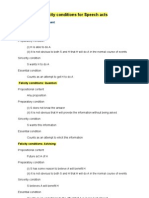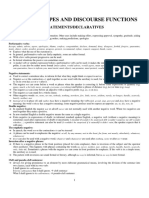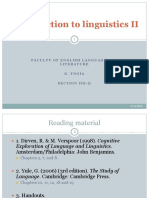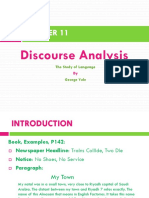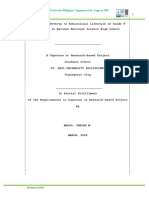Psychological Basis of CA
Psychological Basis of CA
Uploaded by
Maria GabrielaCopyright:
Available Formats
Psychological Basis of CA
Psychological Basis of CA
Uploaded by
Maria GabrielaCopyright
Available Formats
Share this document
Did you find this document useful?
Is this content inappropriate?
Copyright:
Available Formats
Psychological Basis of CA
Psychological Basis of CA
Uploaded by
Maria GabrielaCopyright:
Available Formats
Universidad Nacional de Catamarca Facultad de Humanidades Contrastive Grammar Psychological Basis of Contrastive Analysis
Mara Gabriela Villa May, 2012
SET III: THE PSYCHOLOGICAL BASIS OF CONTRASTIVE ANALYSIS CA is a hybrid drawing between
Psychology Learning processes TRANSFER
Linguistics Formal properties of language
considered within two different theories of language, two approaches
Behaviourism * S-R Theory
Cognitivism *Cross-Association *Ignorance Hypothesis
Transfer Theory Ellis The hypothesis that the learning of language A will affect the subsequent learning of language B, i.e., the psychological foundation of CA is transfer theory, by means of which gains made in one skill will always be relevant for subsequent gains made in other skills. Most of the experimental investigations of transfer involved learning sets of nonsense-syllables. But, even though the observations came from simplified settings and types of learning in comparison with real-life learning they can serve a theory of real language-learning since it is on this basis that progress is made in science. Moreover, there were experimental findings of transfer effects in bilingualism. Thus, Weinreich (1935) proposes INTERFERENCE as those instances of deviation from the norms of either language which occur in the speech of bilinguals as a result of their familiarity with more than one language. Behaviourism In psychology, associationism is the idea that mental processes operate by the association of one entity with another. For example, identifying pictograms with what they really represent is a mental process developed through association.
Restaurant
Escalators
Hospital
Car Park
In the process of learning, those entities are a stimulus and a response. The Stimulus-Response Theory is based in the reception of stimuli, be it linguistic, non-linguistic or pre-linguistic, which leads to the production of responses, either natural or learnt.
Universidad Nacional de Catamarca Facultad de Humanidades Contrastive Grammar Psychological Basis of Contrastive Analysis
Mara Gabriela Villa May, 2012
Following this concept. It can be said that the psychological basis of CA is transfer theory, elaborated and formulated within a Stimulus-Response (behaviourist) theory of psychology. SOME PROBLEMS IN DEFINING S-R IN SECOND LANGUAGE LEARNING 1. In non-verbal learning, the learner doesn't have to learn the responses but their associations with a particular stimulus, i.e., the L2 utterances, which are the responses, have to be learnt jointly with which stimuli they are to be associated. S: Yes/ No Questions R: Yes, I do / No, I don't. 2. CA is more concerned with teaching rather than learning since teaching involves the predetermination and conventionalization of which stimuli and responses are to be associated. In other words, CA is interested in how learners are taught to appropriately associate a certain response to its stimulus. S: emphasis R: (Cleft Sentence) It was JOHN who did it! 3. Jakobovits (1970) and Bloomfield (1933) S pre-linguistic definition: The environmental conditions that are antecedent to linguistic utterances. S: Feeling cold (pre-linguistic) R: Could you please shut the window? S R: Of course. Richterich (1974) S Communicative need which is prior to the interaction. The stimulus reception is unavoidable while the response is a choice. S: Sadness (Communicative need) R: I miss him so much. S R: Yes, I miss him too. Richterich disregards the stimulus's conception as purely linguistic and also finds it contradictory because language behaviour is a two-way process a R may become in turn a S . 4. The response in language behaviour is the utterance, which is Linguistics object of study. However, linguistic descriptions only account for language as a system, and as such, they deal with sentences and not with utterances. Utterances undergo a process of abstraction to be studied as sentences; and since one sentence may underlay many concrete utterances, predictions can only be made as regards the form and not the substance. As a result, CA is more interested in generalizations rather than in the utterances themselves. CA AND COGNITIVIST LEARNING THEORY Individuals tend to transfer the forms and meanings of their native language and culture as well as their distributions to the foreign language and culture. Lado (1957)
Universidad Nacional de Catamarca Facultad de Humanidades Contrastive Grammar Psychological Basis of Contrastive Analysis
Mara Gabriela Villa May, 2012
From this idea, it is stated that CA is founded on the assumption that L2 learners will tend to transfer the formal features of their L1 to their L2 utterances. However, in the 60's, this transfer theory so far explained through the behaviourist perspective was supplanted by explanations from cognitive psychology. As far as theories of language are concerned, the turning point is marked by Chomsky's review of Skinner's Verbal Behaviour, which suggested that language which could be acquired like a habit by a programme of S-R and reinforcement was a form of conditioned behaviour. Based on cognitivism, CA considers as L1 transfer H. V. George's mechanism of Crossassociation as well as Newmark and Reibel's Ignorance Hypothesis. Cross-association H. V. George (1972) Cross-association underlies what is usually meant by Mother-Tongue interference. George presents the concept of redundancy as a type of interference which occurs when one term with different associations in L1 splits up in different terms in L2 producing instances of errors when transferring it inappropriately to L2. Cielo Sky Heaven E.g. *My grandmother is in the sky. Therefore, L1 Spanish learner of L2 (English) says the incorrect because English is more redundant than his/her own language. Ignorance Hypothesis Newmark and Reibel (1968) The errors of L2 learners are explained through a cognitivist alternative to L1 transfer. The L2 learner may want to say something he/she doesn't yet know how to say in the L2 and uses whatever means at disposal. Selinker (1972) proposes ignorance as a precondition for learning since the learner realizes he/she has no linguistic competence with regard to some aspect of L2; as well as a precondition for interference, which predicts that if a learner is called upon to produce some L2 form which he/she has not learnt, he will tend to produce an erroneous form having its origin in L1. When L1 and L2 formal devices are identical, learners will transfer them successfully; but it is when they differ greatly that interference arises and learners transfer the L1 item erroneously. However, ignorance and interference refer to different phenomena and one doesn't necessarily imply the other. Duskova (1969) explains this distinction: Ignorance without interference Learners who have experienced difficulty in using some L2 structure will prefer to make use of paraphrasing or some near equivalent. This is known as the avoidance strategy. E.g. tag questions, collocations, phrasal verbs, idioms Interference without ignorance The learning of a certain structure in L2 becomes error-free, i.e., there is no longer ignorance about it. However, mistakes can still be made. E.g. people IS, news ARE
Universidad Nacional de Catamarca Facultad de Humanidades Contrastive Grammar Psychological Basis of Contrastive Analysis
Mara Gabriela Villa May, 2012
Kellerman (1977) describes weaknesses associated with ignorance hypothesis i. Ignorance by self-evaluation implies a personal auto-evaluation that the learner makes about a feature in his/her own knowledge which he/she finds lacking; so he/she thinks himself/herself incapable of producing it. Now, how does the learner evaluate the presence of such structure in his/her knowledge if he/she is ignorant of it? ii. Different L1 learners may have the same ignorance of a L2 structure; however, it doesn't imply committing the same mistakes. L2 (English) Structure: Where do you come from? L1 Russian Speaker: ? (Lit. Where you from?) L1 Spanish Speaker: De donde es usted? (Lit. From where are you?) The learning of the L2 structure can be influenced by one's first language, and therefore a L1 Russian learner of L2 English and a L1 Spanish learner of L2 English may produce different mistakes when dealing with the same structure. iii. Learners are said to use whatever means at disposal when they want to produce something they don't yet know how to. However, they cannot be asked to perform specific L2 items before being given access and exposure to the items in question. Kellerman is concerned with L2 acquisition but not L2 learning. Krashen (1976)
Acquisition Learning process which takes place in a natural setting without professional or tutored instruction.
Learning It implies teaching
You might also like
- Organisation Behavior in SportDocument19 pagesOrganisation Behavior in Sportakshit100% (2)
- Annotated BibliographyDocument7 pagesAnnotated Bibliographyapi-312485014100% (2)
- Linguistics II HomeworkDocument4 pagesLinguistics II HomeworkRafit Cotoret63% (8)
- Felicity Conditions For Speech ActsDocument2 pagesFelicity Conditions For Speech ActsPham Xuan Tho75% (4)
- SLA Question Bank Chapters 1Document33 pagesSLA Question Bank Chapters 1Ashrath Muhammad100% (8)
- MID-TEST INTRODUCTION TO LINGUISTICS by Josua Prayoga AAA 117 037Document4 pagesMID-TEST INTRODUCTION TO LINGUISTICS by Josua Prayoga AAA 117 037kingNo ratings yet
- Sentence Types and Discourse FunctionsDocument8 pagesSentence Types and Discourse FunctionsPetra BajacNo ratings yet
- List The Morphemes in Each Word Below, and State Whether Each Morpheme Is Free (F)Document10 pagesList The Morphemes in Each Word Below, and State Whether Each Morpheme Is Free (F)samaaliNo ratings yet
- Final ExamDocument4 pagesFinal ExamErina KirantiNo ratings yet
- Contrastive Linguistics Exam QuestionsDocument6 pagesContrastive Linguistics Exam QuestionsKaro_DvasiaNo ratings yet
- Sample Semantics Mid-Term TestDocument2 pagesSample Semantics Mid-Term TestNguyen Thu Hang100% (2)
- Language Testing and Assessment: Day 6 - Test Design Reliability and ValidityDocument45 pagesLanguage Testing and Assessment: Day 6 - Test Design Reliability and Validitycitc_11No ratings yet
- Overview of The Chapter 13 (Groups and Team)Document11 pagesOverview of The Chapter 13 (Groups and Team)fitrieyfieyNo ratings yet
- The Psychological Basis of CADocument17 pagesThe Psychological Basis of CAMaria Gabriela100% (3)
- PPTDocument31 pagesPPTHaikal Azhari100% (4)
- Analytic and Synthetic StatementsDocument3 pagesAnalytic and Synthetic StatementsabayahiaNo ratings yet
- Mini Test Chapter 1 - Discourse AnalysisDocument2 pagesMini Test Chapter 1 - Discourse AnalysisHung Dung75% (4)
- Summary Assignment For Final Exam Introduction To LinguisticsDocument19 pagesSummary Assignment For Final Exam Introduction To LinguisticsLESGEN YULLNo ratings yet
- Syntax Assessment 1 Part I. Choose The Letter of The Correct AnswerDocument6 pagesSyntax Assessment 1 Part I. Choose The Letter of The Correct AnswerCamila Aguilar AlmendralNo ratings yet
- Phonemes and AllophonesDocument14 pagesPhonemes and AllophonesKarla PereyraNo ratings yet
- QUESTIONS - On - Cooperation and ImplicatureDocument2 pagesQUESTIONS - On - Cooperation and ImplicatureTuan Pham100% (1)
- Samples of Exam QuestionsDocument5 pagesSamples of Exam Questionsdhimas_perkasa0% (1)
- The Physical Adaptation SourceDocument4 pagesThe Physical Adaptation SourceRubén Zapata50% (2)
- Pragmatics and Discourse AnalysisDocument14 pagesPragmatics and Discourse AnalysisDr Abdus SattarNo ratings yet
- Semantics Fields Group 3Document3 pagesSemantics Fields Group 3lazytNo ratings yet
- Test - Yule Chapter 18 - Language and Regional Variation - QuizletDocument3 pagesTest - Yule Chapter 18 - Language and Regional Variation - QuizletHussain K .Neama100% (3)
- Clipping: Examples and ObservationsDocument2 pagesClipping: Examples and ObservationsDani Silva100% (1)
- MIDTERM Exams Morphology and SyntaxDocument2 pagesMIDTERM Exams Morphology and SyntaxMerian PadlanNo ratings yet
- Semantic Assignment 1Document8 pagesSemantic Assignment 1Anggoro SasongkoNo ratings yet
- Manners of ArticulationDocument4 pagesManners of ArticulationJejengFajarKusumaNingrum100% (1)
- Participant Roles Exercises and ExamplesDocument4 pagesParticipant Roles Exercises and ExamplesMar CrespoNo ratings yet
- English Reviewer 1Document58 pagesEnglish Reviewer 1Zandro S. BautistaNo ratings yet
- Sociolinguistics - Final Exam PaperDocument9 pagesSociolinguistics - Final Exam PaperEko Kurniawan100% (3)
- ESL101Document29 pagesESL101myhdca172092100% (1)
- Câu 1.what Are Lexical Meaning and Grammatical Meaning?Document42 pagesCâu 1.what Are Lexical Meaning and Grammatical Meaning?Lê Thảo QuyênNo ratings yet
- Morphology - Short QuizDocument4 pagesMorphology - Short QuizHarry TapiaNo ratings yet
- What Is Contrastive LinguisticsDocument6 pagesWhat Is Contrastive LinguisticsMaffy MahmoodNo ratings yet
- Chapter 11 - Discourse AnalysisDocument27 pagesChapter 11 - Discourse AnalysisHussain K .NeamaNo ratings yet
- Stylistics TestDocument3 pagesStylistics TestDherick Raleigh50% (2)
- AllomorphDocument9 pagesAllomorphgiyatmiNo ratings yet
- English Morphology ExercisesDocument14 pagesEnglish Morphology ExercisesStef Gabriela100% (1)
- Notes On Introduction To LinguisticsDocument16 pagesNotes On Introduction To LinguisticsMuhammad Tayyab Ahmad100% (1)
- Sematics Unit 9 - PT 1-Sense Properties and StereotypesDocument28 pagesSematics Unit 9 - PT 1-Sense Properties and StereotypesHilma SuryaniNo ratings yet
- Semantic RoeDocument2 pagesSemantic RoePutri Nila Sudewi50% (2)
- Branches of LinguisticsDocument6 pagesBranches of LinguisticsNdah0% (1)
- Basic Features of CLTDocument9 pagesBasic Features of CLTMashella Mazinal100% (2)
- Linguistics II - Presupositions, Entailments and ImplicaturesDocument6 pagesLinguistics II - Presupositions, Entailments and ImplicaturesMariana Santolin100% (1)
- LING-01.PPT Introduction To Linguistics Dr. David F. MaasDocument20 pagesLING-01.PPT Introduction To Linguistics Dr. David F. MaasDavid F Maas100% (1)
- English Semantics and PragmaticsDocument145 pagesEnglish Semantics and PragmaticsThao Tran83% (6)
- Exercises Unit1 2 SemanticsDocument3 pagesExercises Unit1 2 SemanticsKiều OanhNo ratings yet
- Revision For Phonetics and Phonology I. True / False: Decide Whether The Following Statements Are True or FalseDocument12 pagesRevision For Phonetics and Phonology I. True / False: Decide Whether The Following Statements Are True or FalseMai LinhNo ratings yet
- Cohesion in Discourse Analysis - Group 10Document47 pagesCohesion in Discourse Analysis - Group 10Kim Que Hoang100% (4)
- (Elt) The Linguistics of Contrastive AnalysisDocument22 pages(Elt) The Linguistics of Contrastive Analysislolalo123100% (2)
- Morphology & Syntax, Final Exam, Regular 2013Document1 pageMorphology & Syntax, Final Exam, Regular 2013Dr. Abdullah Shaghi100% (2)
- Chapter 20 - Language and Culture Flashcards - QuizletDocument2 pagesChapter 20 - Language and Culture Flashcards - QuizletHussain K .Neama100% (2)
- Contrastive Linguistics and Contrastive Analysis HypothesisDocument44 pagesContrastive Linguistics and Contrastive Analysis HypothesisKhawla Adnan63% (8)
- JurnalistikDocument4 pagesJurnalistikMikhael Yedija100% (1)
- Defining GroupsDocument4 pagesDefining Groupsikot111100% (1)
- Worksheet 10 Conversational Maxims EtcDocument5 pagesWorksheet 10 Conversational Maxims EtcDiana RNo ratings yet
- Roger AndersenDocument4 pagesRoger AndersenLovelyn MaristelaNo ratings yet
- 4.theories of Second 15Document59 pages4.theories of Second 15Lebiram MabzNo ratings yet
- Contrastive AnalysisDocument34 pagesContrastive AnalysisMelany SiasatNo ratings yet
- PBI207 Contrastive Analysis Contrastive Analysis .: Siti Mahripah, M.App - LingDocument34 pagesPBI207 Contrastive Analysis Contrastive Analysis .: Siti Mahripah, M.App - LingFarhan HadiNo ratings yet
- Early Approaches To Second Language Acquisition - Written ReportDocument6 pagesEarly Approaches To Second Language Acquisition - Written ReportMark Andrew Fernandez90% (10)
- Continuous Provision Malleable AreaDocument1 pageContinuous Provision Malleable AreabojvicNo ratings yet
- Chapter 5Document6 pagesChapter 5Muhammad YouneebNo ratings yet
- Homosexual Parents - CameronDocument6 pagesHomosexual Parents - Cameronalosno calle realNo ratings yet
- Albert Bandura's Social Cognitive TheoryDocument24 pagesAlbert Bandura's Social Cognitive TheoryMs. Huma JavedNo ratings yet
- Capstone or Research-Based ProjectDocument18 pagesCapstone or Research-Based ProjectanamayamigoNo ratings yet
- Rift Valley UnivesityDocument37 pagesRift Valley Univesitymohammed hajiademNo ratings yet
- Socio-Emotional ReportDocument4 pagesSocio-Emotional Reportapi-392251988No ratings yet
- Leadership Case Study: Emotional Intelligence Effect in Our LifeDocument7 pagesLeadership Case Study: Emotional Intelligence Effect in Our LifeRoopa GanachariNo ratings yet
- Cognitive Distortions WorkbookDocument38 pagesCognitive Distortions Workbookbountystorm6394No ratings yet
- Secrets of Success: - What Parents Don't Know Teachers Never TellDocument5 pagesSecrets of Success: - What Parents Don't Know Teachers Never TellK. NeerajNo ratings yet
- HRD Lesson 1Document3 pagesHRD Lesson 1muna moonoNo ratings yet
- Psycology of PersonalityDocument4 pagesPsycology of PersonalityOWAIS0% (1)
- The Working Memory Model AQA PsychologyDocument3 pagesThe Working Memory Model AQA Psychologykapoormahek55No ratings yet
- Directing Function PDF IDocument19 pagesDirecting Function PDF IEmanuelLeipaNo ratings yet
- Sternbergs Triarchic Theory PPT 1Document10 pagesSternbergs Triarchic Theory PPT 1api-362967853No ratings yet
- Week 7-Human Resources Theories of Motivation LeadershipDocument28 pagesWeek 7-Human Resources Theories of Motivation Leadershipcpcervantes2842antNo ratings yet
- Activity 2 Work Values - BaguinsodonDocument5 pagesActivity 2 Work Values - BaguinsodonReyknyll BaguinsodonNo ratings yet
- Hull University Dissertation ExamplesDocument5 pagesHull University Dissertation ExamplesWriteMyPapersDiscountCodeCleveland100% (1)
- Abbate 2019Document16 pagesAbbate 2019IrahzaNo ratings yet
- Management: Richard L. DaftDocument24 pagesManagement: Richard L. DaftVitri Fadhillah MaharaniNo ratings yet
- Employee Narrative Template 4Document3 pagesEmployee Narrative Template 4jetrogsarajemaNo ratings yet
- Me Myself and I PDFDocument7 pagesMe Myself and I PDFSteph GonzagaNo ratings yet
- Teaching The Millenials and The Z GenerationDocument38 pagesTeaching The Millenials and The Z GenerationIKA HASANAHNo ratings yet
- Concept Map PlanDocument3 pagesConcept Map PlanLoey100% (1)
- OCTAPACE Analysis - Pride of Cows: OpennessDocument5 pagesOCTAPACE Analysis - Pride of Cows: OpennessTarannum Yogesh DobriyalNo ratings yet
- Introducing Others - English For BeginnersDocument21 pagesIntroducing Others - English For BeginnersRise EnglishNo ratings yet



